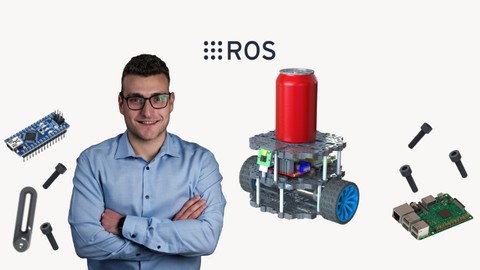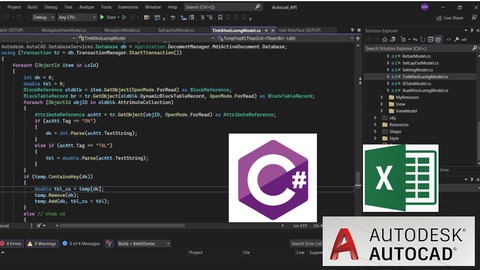STM32L0 Bare-Metal Peripheral Drivers Development
Loại khoá học: Hardware
No Libraries used, Professional CMSIS Standard, ARM Cortex, ADC,UART,TIMERS, GPIO,SPI,I2C etc.
Mô tả
Are you tired of Copying and Pasting code you don't understand?
With a programming based approach, this course is designed to give you a solid foundation in bare-metal firmware development for ARM-based microcontrollers . The goal of this course is to teach you how to navigate the microcontroller reference manual and datasheet to extract the right information to professionally build peripheral drivers and firmware. To achieve this goal, no libraries are used in this course, purely bare-metal embedded-c and register manipulations.
Still keeping it simple, this course comes in different ARM Cortex-M development boards so that students can put the techniques to practice using an ARM Cortex-M development board of their choice. This version of the course uses the STMicroelectronics STM32L0-NUCLEO which has an ARM Cortex-M0+ microcontoller.
So with that understood, let me tell you…
Exactly What You’re Getting
This is dramatically different from any course you have ever taken because it’s more of a professional hands-on “field guide” to stm32 bare metal firmware development.
The reason why is because there’s no fluff or filler. It immediately gets down to the actual subject, showing you exactly what to do, how to do it, and why.
Plus, it’s easy.
And you’ll immediately “get” the entire mythology I personally use to build firmware for consumer devices in my professional life.
It's About MORE Than Just Getting the Code to Work
See, this course will change your professional life forever. Here is what one student had to say about the 1st version (STM32F4) of the course :
"I would suggest this course for all the beginners. The concepts have been covered in the right sequence.And also the best part of this lecture series is getting to know how to explore the reference manual and datasheets."
Here is what another student had to say :
"Extremly helpful to get to understand the uC programming deeper! For me it is much easier from now to develop code because I undertstand the base behind, so I'm more confident and more experienced to develop and debug the code. Really, this course is very useful to link the hardware knowledge with the coding skills. This fills the gap between them. Thanks for it! :)"
A third student :
"I am a professional semiconductor chipset application engineer with 30 years in global embedded product design in system applications. I can say this teacher is very straight forward by sharing his many years knowledge to the students with his true heart. Yes. I love his teaching pace and style!"
The First Version (STM32F4) is being Taken by 5000+ Students with 1000+ Reviews
If at least one of the following applies to you then keep reading if not then simply skip this course:
" Escape From "
Copying/Pasting code you don’t understand
Using third party libraries and header files like HAL, LL and StdPeriph
Experiencing bugs you don’t understand
Being afraid of technical documentations like the reference manual and datasheet of the chip
Imposter syndrome
" Arrive At "
Building every single line of code from scratch by writing to the microcontroller’s memory space directly.
Using No third party libraries or header files
Understanding and writing every single line of code yourself- no Copy/Paste
Using the debugger effectively to analyze and resolve any bugs
Developing proficiency in your embedded development skills and confidently take the next steps
So like I said, there’s more than just getting each piece of code to work.
Here’s an overview of what you’re getting...
Analyzing the chip documentations:
Before developing the firmware for any chip you have to learn how to read the documentation provided by the chip manufacturer.
Defining Peripheral address
All components on the microcontroller have an address range. To write to a component or read from a component you need to locate its address range in the documentation and properly define the addresses in your code.
Creating registers from the address:
The addresses in the address range of a component represent the registers of that component. To access these registers you have effectively typecast the addresses.
Understanding CMSIS:
Cortex-Microcontroller Interface Standard (CMSIS)CMSIS is a standard developed by Arm for all Cortex-Microcontrollers. This is the standard used in professional firmware development
But it gets better because you’re also getting…
Deep Lessons on Developing Peripheral Drivers
You will learn how to develop bare-metal drivers for the following peripherals :
Analog-to-Digital Converter (ADC)
Serial Peripheral Interface (SPI)
Nested Vector Interrupt Controller (NVIC)
General Purpose Timers (TIM)
System Tick Timer (SysTick)
General Purpose Input/Output (GPIO)
Specially Designed For People Who Hate Copy/Paste
Listen. If you don’t like “Copy/Paste” you’re not alone. I can’t stand it either. I’d literally rather have a piece of code that I wrote from scratch that doesn’t work than someone else’s working code I copied and pasted.
And that’s why I’ve spent months designing and recording this course in which I show you how to locate every single register used and the meaning of every hexadecimal value written into the register.
Also it comes with a money back guarantee so you have nothing to loose.
Bạn sẽ học được gì
Write firmware using only bare-metal embedded-c
Understand the Cortex-M Architecture
Write Bare-Metal ADC Drivers for the STM32L0 Microcontroller
Write Bare-Metal TIMER Drivers for the STM32L0 Microcontroller
Write Bare-Metal UART Drivers for the STM32L0 Microcontroller
Write Bare-Metal INTERRUPT Drivers for the STM32L0 Microcontroller
Write Bare-Metal GPIO Drivers for the STM32L0 Microcontroller
Write Bare-Metal SPI Drivers for the STM32L0 Microcontroller
Build every single line of code from scratch by writing to the microcontroller’s memory space directly.
Use No third party libraries or header files
Understand and write every single line of code yourself- no Copy/Paste
Use the debugger effectively to analyze and resolve any bugs
Develop proficiency in your embedded development skills and confidently take the next steps
Define addresses for the different peripherals
Analyze the chip documentation
Create registers from the addresses
Yêu cầu
- NUCLEO-STM32L0 DEVELOPMENT BOARD
- No programming experience needed - I'll teach you everything you need to know.
Nội dung khoá học
Viết Bình Luận
Khoá học liên quan

Đăng ký get khoá học Udemy - Unica - Gitiho giá chỉ 50k!
Get khoá học giá rẻ ngay trước khi bị fix.







![Java Certification : OCA (1Z0-808) Exam Simulation [2023]](/uploads/courses/udemy/1464072_c364_6.jpg)






![10 Sample Exams ISTQB Foundation Level (CTFL) v4.0 [NEW!]](/uploads/courses/udemy/3228307_dcb2_10.jpg)



Đánh giá của học viên
Bình luận khách hàng